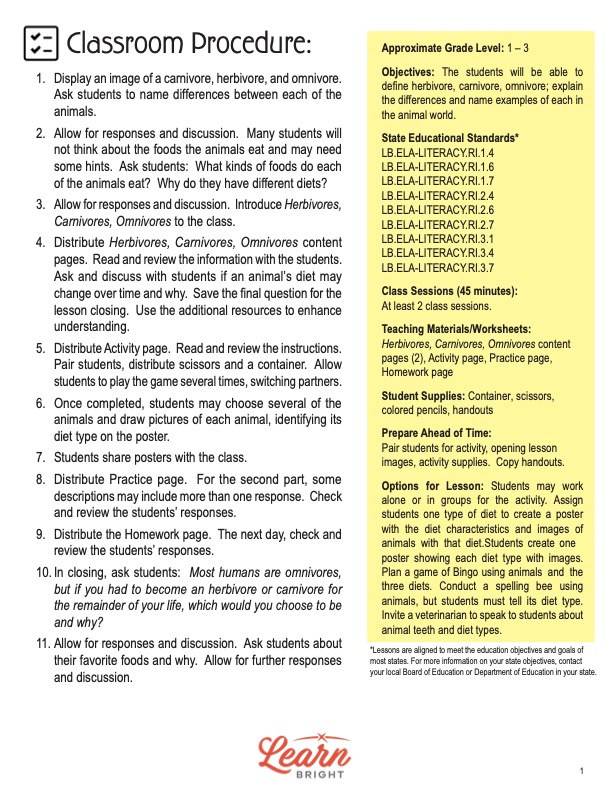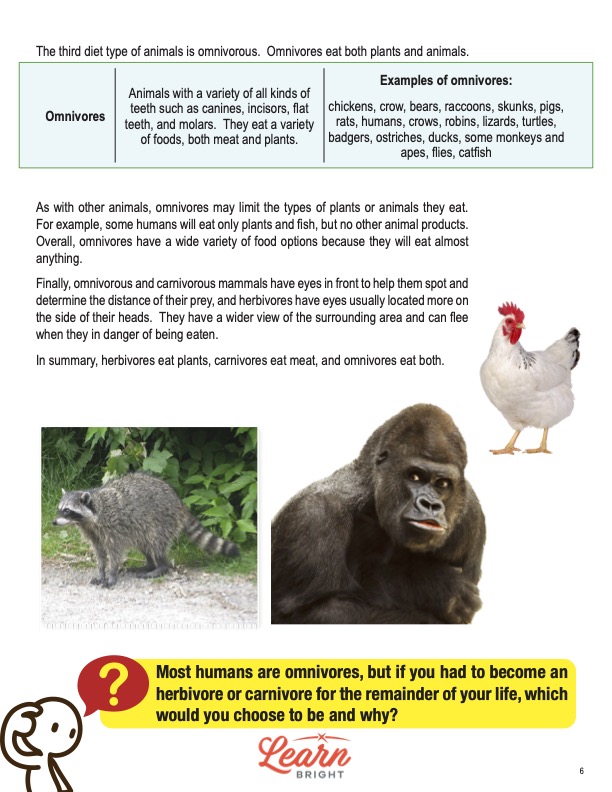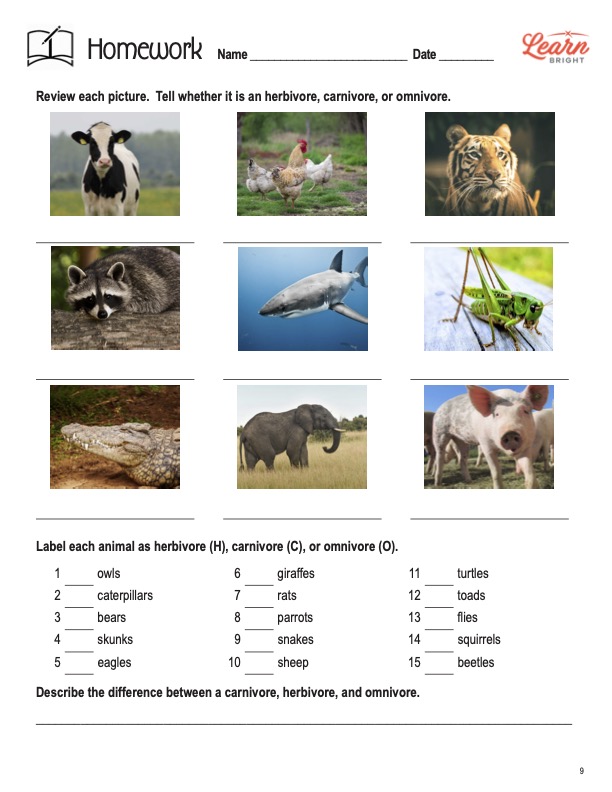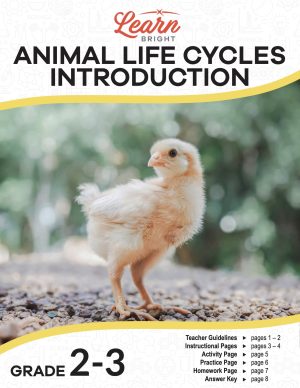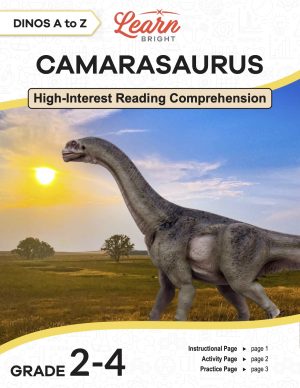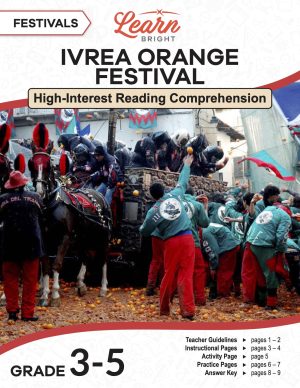Description
What our Herbivores, Carnivores, Omnivores lesson plan includes
Lesson Objectives and Overview: Herbivores, Carnivores, Omnivores explores the three different kinds of diets of various animals (and even plants). Students will be able to define the three terms and explain the differences between them. They will also be able to name examples of animals that fall into each category. This lesson is for students in 1st grade, 2nd grade, and 3rd grade.
Classroom Procedure
Every lesson plan provides you with a classroom procedure page that outlines a step-by-step guide to follow. You do not have to follow the guide exactly. The guide helps you organize the lesson and details when to hand out worksheets. It also lists information in the yellow box that you might find useful. You will find the lesson objectives, state standards, and number of class sessions the lesson should take to complete in this area. In addition, it describes the supplies you will need as well as what and how you need to prepare beforehand.
Options for Lesson
The classroom procedure page includes the “Options for Lesson” section, which provides several ideas of additional activities or alternative ways to go about the lesson. One idea is to assign students one diet and have them create a poster that lists that diet’s characteristics and includes pictures of the animals that follow it. Students could also create one poster that shows each type of diet with related images. Another option is to plan a game of Bingo using the various animals and the words herbivore, carnivore, and omnivore. You could also conduct a spelling bee where students spell the animal words but also have to name its diet. One last idea is to invite a veterinarian to speak to the class about the teeth of animals with different diets.
Teacher Notes
The teacher notes page provides and extra paragraph of guidance for the lesson as you prepare. It suggests teaching this lesson in conjunction with others that relate to animals. You can use the blank lines on this page to write down other thoughts you have before giving the lesson to your students.
HERBIVORES, CARNIVORES, OMNIVORES LESSON PLAN CONTENT PAGES
Introduction to the Diets
The Herbivores, Carnivores, Omnivores lesson plan contains four content pages. The first page explains to students what the suffix –vore means. The suffix means to eat or devour. The actual food something eats or devours depends on the prefix. This lesson describes three different diets.
Herbivores eat foods from plants only because herbi– is a Latin prefix that pertains to plants. Carnivores eat meat or animal flesh only because carni– is a Latin prefix meaning meat or flesh. And omnivores eat everything because omni– is a Latin prefix that means everything or all. Most human beings are omnivores because they eat both plants, like fruits and vegetables, and animals, like beef or chicken.
Every animal in the world has at least one thing in common: they all have to eat. There is a huge variety of foods to choose from. Some animals only eat other animals. Some animals rely on only plant-based foods. And then there are animals that will eat both plants and other animals. The diet of any animals species depends on whether the animals are herbivores, carnivores, or omnivores.
Scientists often study a species’ teeth or eye position to determine whether it eats meat only, plants only, or both. For instance, they can determine whether an animal is carnivorous based on the presence of canine teeth. The canine tooth is a pointed, cone-shaped tooth that animals use to bite and chew. And if an animal’s eyes are both front facing, it is likely it is either omnivorous or carnivorous. If they are on the side, however, it is more likely herbivorous.
Herbivores
Students will learn some of the traits that the animals in each category have in common. Herbivores generally include animals with dull or no canine teeth. Their side and back teeth are also big and flat. They use their teeth (also called molars) to crush and grind plants. Examples of herbivores include sheep, cows, elephants, giraffes, kangaroos, and grasshoppers.
Not all herbivores are the same and not all of them eat the same foods. Some will only eat grasses while others can eat other types of plants. Birds, bees, and butterflies, for example, eat the nectar from flowers, which provides them with the nutrients they need to survive. Other herbivores only eat seeds or fruits. The word to describe people who choose to mainly eat plants or plant-based foods is vegetarian. Most people, however, are omnivores.
Carnivores
Next, students will learn about carnivores. These animals have long, sharp canine teeth next to their front teeth. They also have sharp cheek teeth called carnassials. The animals use their carnassials to help cut up meat in their mouths. They use their canines to seize and stab their prey. Animals in this category include lions, spiders, owls, sharks, praying mantis, snakes, wolves, and dragonflies.
Meat provides a lot of energy to carnivores. They find their food by hunting down their prey or scavenging dead animal tissue. In other words, some carnivores hunt and kill live animals while others just eat the flesh of dead animals. A few common traits among many carnivores are big claws, sharp teeth or beaks, and quick speed.
Omnivores
The final diet type is omnivorous. Omnivores are animals with all kinds of teeth, including canines, incisors, and flat teeth. These animals eat a variety of foods that come from both meat and plant sources. Examples of these animals include chickens, bears, raccoons, pigs, humans, lizards, turtles, ostriches, and some monkeys.
Omnivores may limit the types of plants or animals they consume, just like the animals in the other two groups. Some humans will only eat plants and fish and refuse other animal products. Overall, omnivores have a wide variety of food options because they will eat almost anything.
Key Terms
Here is a list of the vocabulary words students will learn in this lesson plan:
- -vore: the Latin suffix meaning to eat or devour
- Herbi-: the Latin prefix meaning plants
- Carni-: the Latin prefix meaning meat or flesh
- Omni-: the Latin prefix meaning everything or all
- Herbivore: an animal that eats only plants or plant-based foods
- Carnivore: an animal (or plant) that eats only meat or animal flesh
- Omnivore: an animal that eats both meat and plants
- Canine tooth: a pointed, cone-shaped tooth used for biting and chewing
- Molar: a type of tooth used for crushing and grinding
- Vegetarian: a person who eats mainly plants or plant-based foods and no meat
- Incisors: the front teeth of certain animals
- Carnassials: the sharp cheek teeth that some animals have and use to cut up meat in the mouth
HERBIVORES, CARNIVORES, OMNIVORES LESSON PLAN WORKSHEETS
The Herbivores, Carnivores, Omnivores lesson plan includes three worksheets: an activity worksheet, a practice worksheet, and a homework assignment. Each of these handouts will help students solidify their grasp of the lesson material. You can refer to the guide on the classroom procedure page to determine when to hand out each worksheet to your class.
DIET MATCH ACTIVITY WORKSHEET
Students will work with a partner for the activity. First, they will cut out the 36 squares of animal names on the worksheet and place them into a container. They will then take turns taking out two slips of paper at a time from the container. If the animals on the slips of paper both follow the same diet (herbivore, carnivore, omnivore), the student will keep them. If the two animals have different diets, the student will return the papers to the container. The winner will be the partner who has the most animals pairs at the end of the game.
MATCHING PRACTICE WORKSHEET
The practice worksheet contains two sections. The first section requires students to match definitions to the correct terms in the word bank. There are 10 total definition and words to match. For the second section, students will decide whether descriptions represent herbivores (H), carnivores (C), and/or omnivores (O).
HERBIVORES, CARNIVORES, OMNIVORES HOMEWORK ASSIGNMENT
Similar to the practice worksheet, the homework assignment has multiple sections. For the first section, students will look at nine pictures. They will then decide whether the picture represents an herbivore (H), a carnivore (C), or an omnivore (O). The next section requires students to label animals as herbivores (H), carnivores (C), or omnivores (O). There are 15 animals to label in this section. Finally, students will describe the differences between the three diet types.
Worksheet Answer Keys
The last two pages of the lesson plan document are answer keys for the practice and homework worksheets. The answers for both are in red. For the final prompt on the homework assignment, students’ responses may vary slightly. However, their answers should be pretty close to the one on the answer key. If you choose to administer the lesson pages to your students via PDF, you will need to save a new file that omits these pages. Otherwise, you can simply print out the applicable pages and keep these as reference for yourself when grading assignments.


